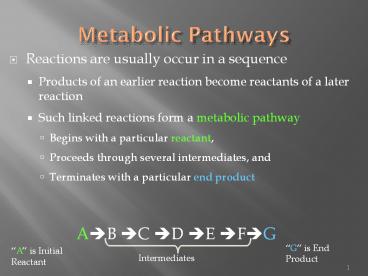Metabolic Pathways - PowerPoint PPT Presentation
Title:
Metabolic Pathways
Description:
Reactions are usually occur in a sequence Products of an earlier reaction become reactants of a later reaction Such linked reactions form a metabolic pathway – PowerPoint PPT presentation
Number of Views:464
Avg rating:3.0/5.0
Title: Metabolic Pathways
1
Metabolic Pathways
- Reactions are usually occur in a sequence
- Products of an earlier reaction become reactants
of a later reaction - Such linked reactions form a metabolic pathway
- Begins with a particular reactant,
- Proceeds through several intermediates, and
- Terminates with a particular end product
A?B ?C ?D ?E ?F?G
G is EndProduct
A is InitialReactant
Intermediates
2
Enzymes
- Enzymes
- Protein molecules that function as catalysts
- The reactants of an enzymatically accelerated
reaction are called substrates - Each enzyme accelerates a specific reaction
- Each reaction in a metabolic pathway requires a
unique and specific enzyme - End product will not appear unless ALL enzymes
present and functional
E1 E2 E3 E4 E5 E6 A ? B ? C ? D ? E
? F ? G
3
EnzymesEnergy of Activation
- Reactants often reluctant to participate in
reaction - Energy must be added to at least one reactant to
initiate the reaction - Energy of activation
- Enzyme Operation
- Enzymes operate by lowering the energy of
activation - Accomplished by bringing the substrates into
contact with one another
4
Enzyme-Substrate Complex
- The active site complexes with the substrates
- Causes active site to change shape
- Shape change forces substrates together,
initiating bond - Induced fit model
5
Induced Fit Model
6
Degradation vs. Synthesis
- Degradation
- Enzyme complexes with a single substrate molecule
- Substrate is broken apart into two product
molecules - Synthesis
- Enzyme complexes with two substrate molecules
- Substrates are joined together and released as
single product molecule
7
Degradation vs. Synthesis
8
Factors Affecting Enzyme Activity
- Substrate concentration
- Enzyme activity increases with substrate
concentration - More collisions between substrate molecules and
the enzyme - Temperature
- Enzyme activity increases with temperature
- Warmer temperatures cause more effective
collisions between enzyme and substrate - However, hot temperatures destroy enzyme
- pH
- Most enzymes are optimized for a particular pH
9
Factors Affecting Enzyme ActivityTemperature
10
Factors Affecting Enzyme ActivitypH
11
Factors Affecting Enzyme Activity
- Cells can affect presence/absence of enzyme
- Cells can affect concentration of enzyme
- Cells can activate or deactivate enzyme
- Enzyme Cofactors
- Molecules required to activate enzyme
- Coenzymes are organic cofactors, like some
vitamins - Phosphorylation some require addition of a
phosphate
12
Factors Affecting Enzyme ActivityActivation by
Phosphorylation
13
Factors Affecting Enzyme Activity
- Reversible enzyme inhibition
- When a substance known as an inhibitor binds to
an enzyme and decreases its activity - Competitive inhibition substrate and the
inhibitor are both able to bind to active site - Noncompetitive inhibition the inhibitor binds
not at the active site, but at the allosteric
site - Feedback inhibition The end product of a
pathway inhibits the pathways first enzyme
14
Competitive Inhibition
15
Factors Affecting Enzyme ActivityFeedback
Inhibition































